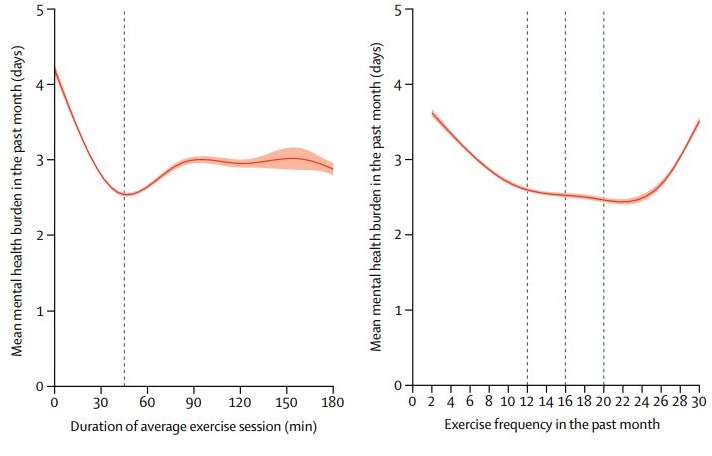2020 has been a challenging year for everyone and, unfortunately, it has taken a huge toll on peoples’ mental health. A recent survey conducted on the acute mental health responses during the pandemic in Australia revealed more than three quarters of Australians felt their mental health had declined since the outbreak, of which 23% felt “a lot worse”1
Prioritising our mental wellbeing is an important part of staying healthy. People know that exercise helps physical outcomes, but there is much less awareness of its importance in mental health and how2. Exercise and physical activity are important for maintaining mental health and promoting overall health and wellbeing, however during the pandemic less than half of Australians were meeting national guidelines for 150 minutes of moderate to vigorous physical activity per week1
Exercise & Improved Mood
Evidence indicates that regular physical activity may be protective against depression, whereas physical inactivity is a risk factor3. A review of the literature found that the effects most consistently reported are decreases in stress levels and alleviating negative, while enhancing positive, mood states4. A cross-sectional study by Pasco et al5 of almost 300 women over the age of 20 examining the association between habitual physical activity and affect found higher positive affect scores encompassing emotions such as interest, excitement, enthusiasm, and alertness were associated with higher levels of physical activity.
Physiological effects of exercise on the brain can be described in terms of those occurring with acute exercise, i.e. a single bout, or chronic changes induced by multiple bouts of exercise over a prolonged period of time6. Acute exercise bouts have been shown to enhance affective, mood, and emotional states with the mood enhancement usually occurring within 5 mins of moderate exercise2. Chronic regular physical activity induces adaptations which result in longer-term changes in the structure and function in the brain6.
Exercise & Self-Esteem
Exercising gives you a sense of accomplishment as your fitness improves and you start achieving your goals. Individuals who regularly exercise experience better moods than those who do not, and there are improvements in other aspects of life such as self-esteem, vitality, general wellbeing and satisfaction with physical appearance3.
For example, weight training can give you a sense of accomplishment and something you can take pride in, “when you make that lift, or complete your program” according to clinical psychologist Li Faustino. "When you challenge yourself and push yourself, it's really hard not to feel pride when you're done, and pride is the opposite of that depressive, powerless feeling”. One small study, for example, found that 80 percent of older adults with depression experienced a significant reduction in symptoms after a 10-week resistance training program7 and improvement in their self-efficacy. A controlled study with 19 women with depression found that involvement in a 9-week exercise programme provided a meaningful mastery experience through which confidence in their ability to engage in a variety of coping responses was increased and level of depression decreased8.

Exercise & Social Connection
Another hypothesis to explain the beneficial effects of exercise on mental health is through social interaction9. Exercise is often a shared activity with others so you get the benefits of social connection and opportunities for social contact. Where physical activity is done as part of a group, or brings one into contact with other people, there is an opportunity for individuals to increase their social networks and make friends. There is extensive research that shows that good social relationships and networks promote and are a protective factor for wellbeing and mental health10.
How Much Exercise for Good Mental Health?
Aerobic exercises including jogging, running, swimming, cycling, and walking have all been proved to reduce anxiety and depression9. Weightlifting, high intensity interval training (HIIT), and meditative exercises are also popular choices that offer plenty of physical and mental benefits.
A 5-year cross-sectional study featured in the 2018 Lancet Psychiatry series11 examined the effects of exercise type, duration, frequency, and intensity on mental health in over 1 million Americans. They found all types of exercise were associated with a lower mental health burden when compared with not exercising at all. The best mental wellbeing was associated with popular team sports, cycling, and aerobic and gym activities. The following images show the relationship between exercise duration (left) and exercise frequency (right) with mental health burden. As we can see, 30 to 60mins (peaking at 45mins) was associated with a lower mental health burden, i.e. better reported mental health. There was a U-shaped relationship between exercise frequency and mental health whereby individuals who exercised between 3 to 5 times per week had a lower mental health burden than those who exercised fewer than three or more than five times.

In terms of intensity, they found that vigorous exercise had better outcomes than light or moderate, but once again, all were better than no exercise at all11. Recently, researchers at the University of Texas Southwestern Medical College studied exercise as a secondary treatment for patients with major depressive disorder who hadn't achieved remission through drugs alone. They evaluated two exercise doses: One group of patients burned four kilocalories per kilogram each week, while another burned 16 kilocalories per kilogram weekly. They found both exercise protocols led to significant improvements, though the higher-dose exercise program was more effective for most patients12 This suggest that higher-intensity exercise may be better.
If you feel like these recommendations are unachievable, think again! Studies have shown that even walking for 10-12 minutes has been shown to be sufficient to have a positive impact on mood states13. This offers a practical way to perform some physical activity in short bursts and still have positive effects on mental health
References
- Newby JM, O’Moore K, Tang S, Christensen H, & Faase K (2020) Acute mental health responses during the COVID-19 pandemic in Australia. PLoS ONE. 15(7): e0236562. Available at: https://doi.org/10.1371/journal.pone.0236562
- Weir K (2011) The exercise effect. Monitor on Psychology. 42(11): 48
- Peluso MAM & Andrade LHSG (2005) Physical activity and mental health: the association between exercise and mood. Clinics. 60(1): 61-70
- Basso JC & Suzuki WA (2017) The effects of acute exercise on mood cognition, neurophysiology, and neurochemical pathways: A review. Brain Plasticity. 2(2): 127-152
- Pasco JA, Jacka FN, Williams LJ, Brennan SL, Leslie E & Berk M (2011). Don’t worry, be active: positive affect and habitual physical activity. Australian and New Zealand Journal of Psychiatry, 45(12) p. 1047-52
- McMorris T & Corbett J (2013) Neurobiological Changes as an Explanation of Benefits of Exercise. In: Budde H & Wegner M (eds) The Exercise Effect on Mental Health. Neurobiological Mechanisms. Routledge, New York. pp: 30-57
- Singh NA, Clements KM, & Fiatrarone MA (1997) A randomized controlled trial of progressive resistance training in depressed elders. The Journals of Gerontology, Series A, Biological & Medical Sciences. 52(1): 27-35
- Craft LL (2005). Exercise and clinical depression: examining two psychological mechanisms. Psychology of Sport and Exercise, 6(2) p. 151-71
- Sharma A, Madaan V, & Petty FD (2006) Exercise for mental health. The Primary Care Companion to the Journal of Clinical Psychiatry. 8(2): 106
- Heaney CA & Israel BA (2008). Social networks and social support. In: Glanz K, Rimer BK, Viswanath K, editors. Health behavior and health education: theory, research, and practice. 4th ed. San Francisco: Jossey-Bass. p. 189-210
- Chekroud SR, Gueorguieva R, Zheutlin AB et al (2018) Association between physical exercise and mental health in 1.2 million individuals in the USA between 2011 and 2015: a cross-sectional study. The Lancet – Psychiatry. 5(9): 739-746
- Trivedi MH, Greer TL, Church TS et al (2011) Exercise as an augmentation treatment for nonremitted major depressive disorder: a randomized, parallel dose comparison. Journal of Clinical Psychiatry. 72(5): 677-684
- Ekkekakis P, Hall EE, VanLanduyt LM & Petruzzello SJ (2000). Walking in (affective) circles: Can short walks enhance affect? Journal of Behavioral Medicine, 23(3) p. 245-75.
